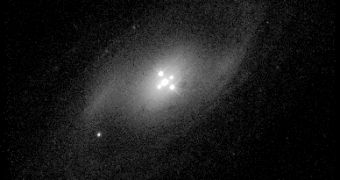An international team of astronomers from Europe and the US have been able to infer a lot of data based on the observations of Einstein Cross made by ESO's Very Large Telescope (VLT). This cosmic event, which largely magnifies the image of a very distant object, allowed the experts to perform, for the first time, exact measurements of the accretion disk size of a quasar without the help of any model, and to prove theories linked to the relation between energy and distance from a black hole.
The Einstein Cross, also called "macrolensing," is a phenomenon predicted by Einstein as a result of his relativity theory, that occurs when the light from a very distant source (10 billion years in this case) passes through a much closer galaxy (10 times closer, more specifically) in its way to our telescopes.
The gravitational field of the galaxy bends the light and enlarges the image by a significant amount. The stars of the closer galaxy behave in the same manner, further enhancing the effect, but by a smaller amount, in a process called "macrolensing," which also causes the initial image to flicker (due to their movement around the galaxy) and to appear as multiple instances (four, in the case of Einstein Cross).
"Thanks to this unique dataset, we could show that the most energetic radiation is emitted in the central light-day away from the supermassive black hole and, more importantly, that the energy decreases with distance to the black hole almost exactly in the way predicted by theory," explained Alexander Eigenbrod, one of the team's data analyzers, as quoted by PhysOrg.
Combined with the magnifying power of the VLT, the "macrolensing" and "microlensing" effects made areas merely the scale of a millionth of an arcsecond small visible. "The combination of this natural magnification with the use of a big telescope provides us with the sharpest details ever obtained. This is 1000 times better than can be achieved using normal techniques with any existing telescope," shared project leader Frédéric Courbin.
Comparatively, this would be like spotting a €1 coin from about 5 million kilometers away, or 13 times the distance to the Moon. This allowed for precise measurements of temperature distributions around a black hole, as well as for obtaining more insight on the validity of theories on quasar formation. "This is the first accurate and direct measurement of the size of a quasar accretion disc with wavelength (color), independent of any model," stated team member Georges Meylan.

 14 DAY TRIAL //
14 DAY TRIAL //